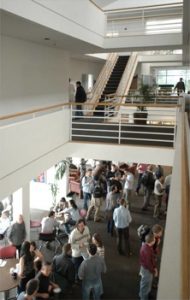While there are some good features in the current mathematics building, there are many improvements needed to give the mathematics department, and the mathematical sciences in general, a first class interaction space which would be part of the investment needed succeed in the quality of hires we envision and to maintain the strong group already built.
Among the primary desirable features are:
-
• More interaction space : both more formal and informal.
-
• informal encounter space with blackboards
-
• More private collaborative space for small working groups and undergraduate help sessions.
-
• Better seminar space of variable size both large and medium size.
-
• A common room with an outdoor section (with outdoor blackboard). This small feature will have an effect on recruiting.
-
• Graduate student offices around a shared interaction space.
-
• Two undergraduate interaction areas: One for quiet study and one for more social group work.
-
• Good lighting and open flow
-
• Multi level sliding blackboards made of real slate, roughened glass, or ceramic on Steel.































































 There is a comfortable common room with indoor and outdoor spaces and blackboards.
There is a comfortable common room with indoor and outdoor spaces and blackboards.






























































